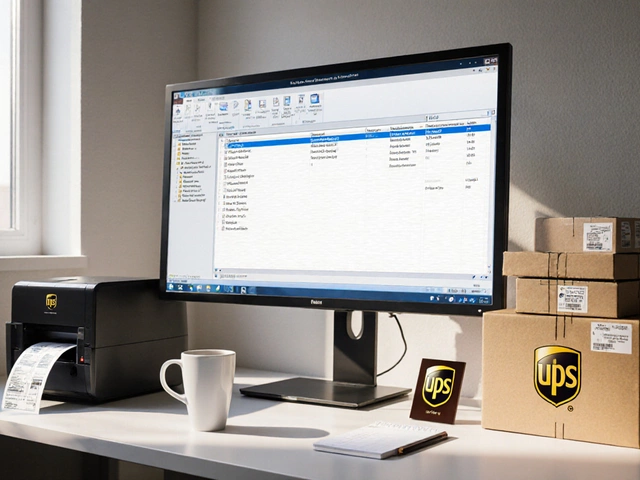Think sending a heavy box is as simple as slapping on a label and crossing your fingers? Not a chance—the numbers behind shipping rates can catch you off guard. Look up UPS or USPS, and you’ll find enough fine print to make your head spin. You can’t get away with a lazy guess when you want to save real money, especially when you’re shipping something that weighs more than your dog or your laundry bag. There are wild differences in how these two shipping giants handle weight, distance, and all the drab surcharges hidden in rate tables. If you’re agonizing over which is cheaper for a hefty package, stick around. The answer isn’t always what you expect.
How UPS and USPS Set Their Prices for Heavy Packages
Heavy boxes are the true test of a shipper’s pricing model. Let’s be real: a five-pound package isn’t where you’ll see mind-blowing differences. But once you break into double and triple digits on the scale, every pound starts to feel like a negotiation with your wallet. Both companies have their quirks, and those quirks matter.
Start with USPS. For big boxes, USPS offers Priority Mail and Priority Mail Express. Priority Mail is the one most people will look at. Unlike some carriers, USPS puts a strict cap: no single package can weigh more than 70 lbs. That’s your absolute limit. Beyond that, you’ve got to look elsewhere—sorry, USPS die-hards. Priority Mail uses either regular rates based on weight and distance traveled (they call it "zone") or their unusual flat-rate options. If your heavy box somehow fits into a flat-rate Large Box (about 12 x 12 x 5.5 inches), it’s a set price no matter if it’s 5 pounds or 30. But that box isn't going to hold a 60-pound dumbbell—it’s size-limited. Most heavy shipments outgrow flat rate fast. You’re left with weight- and distance-based rates (“zone pricing” in USPS jargon), and these almost always rise sharply with each pound after the first few.
Now, UPS. There’s no 70-lb limit—they’ll take packages up to 150 lbs. Boxes heavier than that jump up to freight services. UPS prices, like USPS, rise as the weight goes up, and also depend on how far you ship it (think zip code to zip code—they don’t use "zones" the same way, but the idea is the same). What makes UPS different? There are "accessorial fees" that love to pop up on heavy shipments. Ever seen a Delivery Area Surcharge or "Additional Handling" fee? These can add $15-25 on top of your base price, especially if your box is both heavy and big. UPS Ground is the usual go-to for heavy boxes because it's far cheaper than UPS 2nd Day Air or Next Day Air (those can be two to four times the price of ground shipping for a heavy box!).
This is the kicker: USPS almost always wins for small and lighter boxes—think 1 to 20 lbs—especially if you can cram your stuff into a flat-rate box. But as the package approaches 50, 60, or 70 lbs, and especially if your box is oddly shaped, UPS nearly always becomes the practical (and sometimes only) choice. The cutoff? For most people, right at the 20- to 30-lb mark. After that, USPS surcharges start stacking up fast, and UPS takes the price win, except if you’re shipping to a very close zone. Real-life example: in summer 2024, shipping a 68-lb box from New York to Chicago with USPS Priority Mail cost $170, while the same box with UPS Ground, even after their "large package" fee, came to $110. That price gap balloons if you’re going coast to coast.
heavy box shipping isn’t just about who’s got the lowest base rate, it’s about the whole picture—distance, weight, box dimensions, and those pesky handling fees. Sometimes, those extras with UPS add up to match USPS, but nine times out of ten for truly heavy boxes, UPS is the cheaper and only option.
But don’t skip the USPS calculator—their rates can surprise you if you’re shipping under 20 lbs or sending your package across just one or two states. For instance, a 15-lb box shipped under 150 miles can cost less with USPS Priority Mail than UPS Ground, depending on deals and seasonal surcharges. Seasonality matters—holiday surcharges with UPS can sneak in around late October and stick around through January, so timing your shipment can also keep your costs in check.

Things That Can Blow Up Your Shipping Costs
Even if you nail the right carrier, there’s a parade of hidden factors that can double (or triple) your final price. The carrier’s posted rates are just the tip of the iceberg, so let’s cut through to the hidden stuff that can blow up your budget if you don’t watch out.
First, box size can jack up your price even if your box isn’t close to the 70-lb USPS cutoff or the 150-lb UPS cap. Both carriers use something called “dimensional weight”—usually for boxes that are big and light, like shipping a bunch of pillows—but UPS, in particular, starts using this formula with any package that exceeds 12 x 12 x 12 inches. If your box is bulky but not super heavy, you could get stuck paying the rate for a “phantom weight” that’s way higher than your box’s actual pound count. TIP: If your shipment is heavy but very compact, you’ll often be better off than someone with a big, awkward box of the same weight. Measure twice before you choose a box.
Then there are the infamous surcharges. UPS likes to charge for “Additional Handling” on boxes that are over 48 inches on the longest side or more than 30 inches on the second-longest, or if the box isn’t a regular shape. That’s a $17.50 penalty in July 2025. Shipping to a rural address? UPS adds a "Delivery Area Surcharge"—sometimes $5-7 extra. Residential addresses get hit with another $5 fee per box. USPS has fewer surcharges—it's part of why they're simpler for folks who don't want to squint at rate tables. However, don’t assume there are no pitfalls: if you try to mail a package over the 70-lb limit, USPS will just return it (or refuse to accept it). Not fun if you’re hauling it to a distant post office.
Insurance is another factor that hits big shipments. USPS includes $100 of insurance with Priority Mail; UPS covers up to $100 "declared value" too, but for a heavy box, your stuff’s probably worth a lot more. To add extra coverage, expect to pay $2-$5 more per $100 in value for either carrier. Don’t cheap out here—heavy shipments often mean fragile or expensive gear, and carriers aren’t known for gentle handling. Take pictures of your box’s condition before shipping, just in case you have to file a claim.
Here’s a dirty little secret: shipping software. Some online sellers get discounts negotiated directly with UPS or USPS. Shopify and Pirate Ship, for example, have baked-in commercial rates way lower than what you’ll see at the retail counter. For a 50-lb box, I’ve seen UPS Ground rates through these platforms come in $30 cheaper than walking into a UPS Store. If you’re shipping more than a few times a year, it’s worth signing up—it’s free in most cases, and sometimes you can print your label at home and just drop it off.
Want a few more weird things that spike your price? Shipping batteries or hazardous materials—both carriers have strict rules and will charge extra, or even refuse your package if you don’t follow the right steps. Bad address input can cost you a "Return to Sender" fee at UPS (up to $18!). Always double-check your shipping info. If you’re sending something dense, like gym weights or auto parts, the actual weight is usually your price driver, but toss in a big box and you might get hit with both weight- and dimension-based pricing.
This all sounds complicated, but compare your options—don’t just go by memory or old receipts. Grab each company’s online calculator and crunch the numbers. Your mailbox or local UPS counter can also give you printed lists—their staff has seen all the nasty surprises firsthand.
Here’s a quick table with real recent data for a 50-lb box, 24 x 18 x 12 inches, shipped from Los Angeles, CA to New York, NY as of June 2025:
| Carrier | Service | Base Rate | Additional Fees | Total Cost |
|---|---|---|---|---|
| USPS | Priority Mail | $173 | None | $173 |
| UPS | Ground | $98 | $17.50 (Handling) + $6 (Residential) | $121.50 |
Bottom line: for truly heavy boxes, expect UPS Ground to be $40-$70 cheaper every time, while USPS isn’t even an option once you cross 70 lbs. If your box is under 20 lbs and can fit in a flat-rate box, check USPS—they’re shockingly competitive at that range.

Insider Tips for Getting the Cheapest Rate (and Avoiding Shipping Nightmares)
If you want to keep shipping costs low and hassles to a minimum, bring the right tricks to the table. Small stuff makes a huge difference when you’re dealing with heavy boxes.
- Always check BOTH calculators—UPS and USPS—before you ship. Don’t rely on guesswork or 2018 prices. Rates change quarterly and sometimes monthly.
- Use a shipping software. Pirate Ship (for USPS) and ShipStation (for both) are great. They unlock commercial rates and can save $10-$50 per heavy box.
- Optimize your packaging—keep boxes compact. Remember, with both UPS and USPS, box size can inflate your dimensional weight charge. A snug fit can shave off serious dollars.
- Double-check weight and measure carefully. Rounding up by even a pound or an inch can cost you much more than you expect. Invest in a digital scale if you ship often.
- Avoid odd-shaped boxes. These trigger "Additional Handling" and dimensional fees. Always choose a plain, sturdy rectangular box that fits your items closely.
- If your box is under 20 lbs, always try it with a USPS Priority Mail Flat Rate box first. It’s often the flat-out winner for price—but don’t count on it past 20 lbs or for big dimensions.
- Be wary during holidays. From October through January, UPS and even USPS sneak in surcharges, sometimes called "peak season fees." If possible, ship outside these windows for the best deal.
- If you’re shipping something fragile in a heavy box, splurge on extra insurance. Carriers move boxes with forklifts and don’t always obey the “This Side Up” sign.
- If you have to ship more than 150 lbs, look up "LTL freight" services, not UPS or USPS small package rates. The cost per pound usually plunges, but you’ll need a pallet and someone to accept curbside drop-off.
- Label clearly and include your return address. Bad labels or no return info can mean lost packages and expensive returns, especially at UPS.
Shipping a heavy box is more like chess than checkers—you’ve got to anticipate every move ahead. Always compare your real options with up-to-date tools. Even with all the quirks, fees, and headaches, if you watch your box size, avoid the worst surcharges, and shop for carrier discounts, you’ll dodge the big price tags. And hey, if you think you’ve found a loophole—test it. Heavy box shipping is a game of inches, pounds, and dollars. The carrier with the cheapest deal for your neighbor might not be the same for your address or your stuff. That’s why regular check-ins with both carriers (and maybe a chat with your local shipping clerk) can save you from shipping regret.





